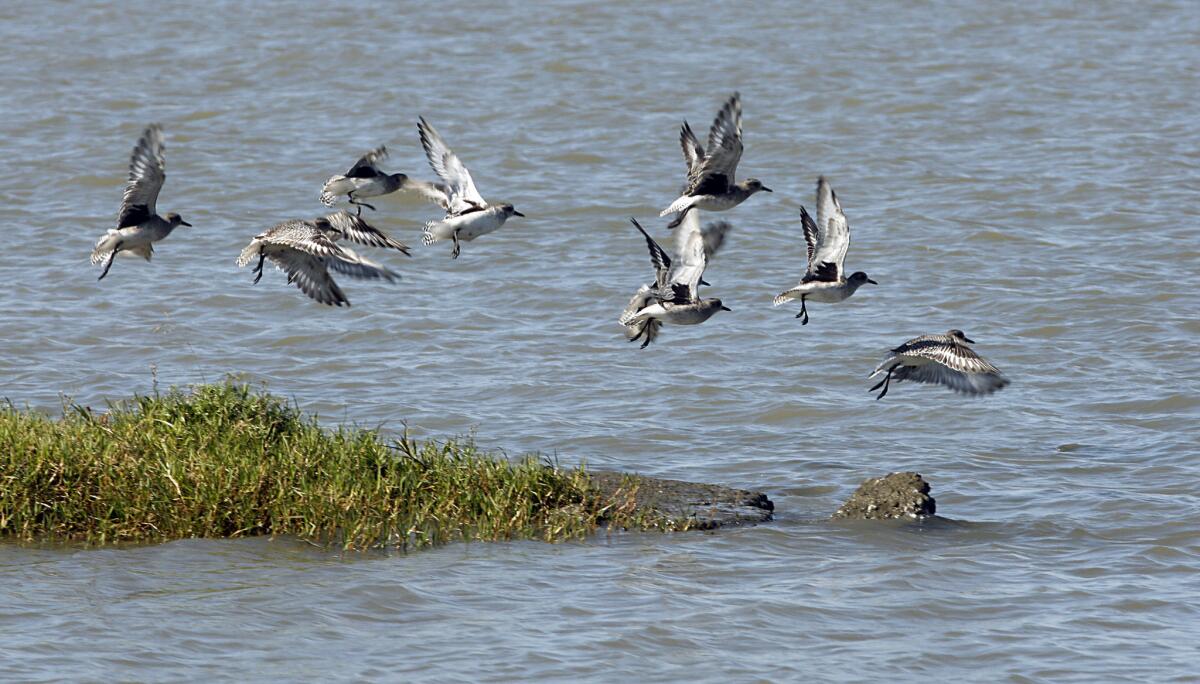Giant tunnels planned for delta ‚Äėmust move forward,‚Äô Brown says

Reporting from Oakland ‚ÄĒ As the hub of California‚Äôs sprawling water system, the Sacramento-San Joaquin delta has been the focus of the state‚Äôs water fights for decades.
Competing interests ‚ÄĒ environmental, urban and agricultural ‚ÄĒ have defeated repeated efforts to come up with a ‚Äúdelta fix‚ÄĚ that would keep copious amounts of water flowing south to the sun-drenched croplands of the San Joaquin Valley and millions of homes in Southern California.
Gov. Jerry Brown’s announcement Thursday that the state is scaling back part of a long-planned project to restore more than 100,000 acres of fish and wildlife habitat and re-engineer the delta was a sign of how elusive that fix remains.
Accompanied by top federal and state environmental officials at a news conference, Brown offered remarks that amounted to funeral rites for the Bay Delta Conservation Plan.
Delta water exporters had hoped the program would yield a 50-year, federal environmental permit insulating them from continued cuts to their deliveries.
The state is still proposing to build a new diversion point on the Sacramento River in the north delta. It would feed two proposed 30-mile tunnels that would carry water to existing delta pumps and southbound aqueducts.
But in the face of continuing resistance from the federal fishery agencies that must approve the project, the state will now seek short-term permits that could grow stricter as delta conditions evolve with climate change.
State officials said they are also dropping plans to spend $8 billion in federal and state money to restore more than 100,000 acres of fish and wildlife habitat over the next five decades. Instead they are settling for a more modest ‚ÄĒ but, they said, more realistic ‚ÄĒ effort to improve 30,000 acres of habitat over the next four or five years at a cost of $300 million, funded with state bond money and other sources.
‚ÄúThis is an imperative. It must move forward,‚ÄĚ Brown said of the project. ‚ÄúThis is not just some piece of rhetoric ‚Ķ this is a serious effort on the part of the federal authorities, state authorities.‚ÄĚ
Without a 50-year guarantee of water supplies, it remains to be seen if the agricultural and urban water contractors who have committed to picking up the $15-billion tab for tunnel construction will persevere.
In statements, several major agencies, including the Metropolitan Water District of Southern California, said they were reserving judgment until they could study details of the new plans, which will be formally released in June in the form of revised environmental documents.
But they acknowledged that it was time to throw in the towel on the conservation plan. ‚ÄúContinuing along the previous pathway toward approval of the Bay Delta Conservation Plan has resulted in repeated obstacles and was not acceptable,‚ÄĚ said Dan Nelson, executive director of the San Luis & Delta-Mendota Water Authority, which represents some San Joaquin Valley irrigation districts. ‚ÄúThe danger of a collapsing delta ecosystem and a faltering economy were too real to allow the previous efforts to drag on.‚ÄĚ
Brown said the contractors ‚Äúhave no choice‚ÄĚ but to stick with the project. ‚ÄúIf they don‚Äôt do this, they are absolutely certain to suffer serious [water] losses in the future,‚ÄĚ he argued.
The drought has heightened delta conflicts as growers have complained that endangered species protections have restricted delta pumping during the few storms that hit the state last winter. Environmentalists, meanwhile, have lamented that the drought is pushing some delta fish species ever closer to extinction.
Part of the largest estuary on the West Coast, the delta has been a bottleneck for decades in California’s complex water system, which revolves around transferring supplies from the water-rich north to the semi-arid, populated south.
The delta’s environmental troubles started in the 1800s, when Gold Rush-era settlers drained its wildlife-rich wetlands and turned them into cropland. As the state’s big government water projects came on line in the 20th century, more and more water was diverted from delta tributaries and the delta itself. Now freshwater flows through the delta to the sea are only about half what they once were.
The federal and state pumping operations in the south delta that fill the big aqueducts headed south have profoundly altered the delta’s hydrology, disturbing the salinity patterns with which native fish evolved. The pumps pull migrating salmon and the tiny delta smelt to their deaths and cause some delta water channels to flow backwards.
That has helped send fish populations plummeting and triggered increasingly strict endangered species protections that have tightened the spigot on delta pumping.
The premise of the conservation plan was that a new diversion system and extensive habitat restoration would improve delta conditions, boost the populations of imperiled fish and ease limits on exports.
But the project, in the planning stages for nearly nine years, has encountered delays and heated opposition from delta growers and some environmentalists who argue the tunnels will inevitably become a vehicle to take more water from the delta’s failing ecosystem.
‚ÄúThis plan has now shifted from a proposal to protect 56 species and over 100,000 acres of habitat to a straight water grab,‚ÄĚ said Barbara Barrigan-Parrilla, executive director of Restore the Delta, a delta group and one of the project‚Äôs most vocal critics.
Federal fishery agencies have also been skeptical that the habitat work would be beneficial for fish species that are suffering from a multitude of problems, most notably the lack of adequate freshwater flows through the delta.
‚ÄúThis is a huge deal for the governor of California to recognize the need for adjustment‚ÄĚ to the project, said William Stelle Jr., West Coast regional administrator for the National Marine Fisheries Service, one of the agencies that has to sign off on the tunnels.
Twitter: @boxall
More to Read
Sign up for Essential California
The most important California stories and recommendations in your inbox every morning.
You may occasionally receive promotional content from the Los Angeles Times.











